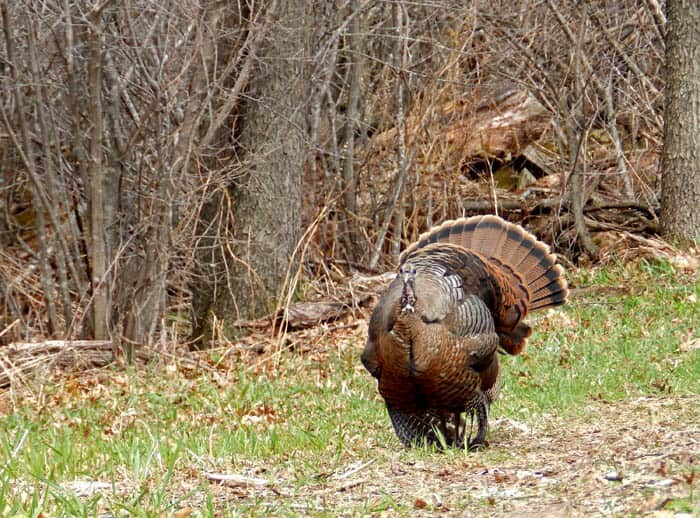Strutting Hens: A Rare Sight in the Turkey Woods
Patrick Durkin 04.22.15

John Obst of McFarland, Wisconsin has seen a true woodland rarity in consecutive springs, and he’s hoping for a three-peat during Wisconsin’s 2015 spring turkey season.
What has Obst twice seen that most turkey hunters have not seen once? A hen turkey in full strut.
Obst was hunting turkeys on a southern Wisconsin farm in April 2013, and called in a hen that was likely curious about his yelps. When the hen saw Obst’s hen decoy, it went into full strut. Obst is an experienced hunter, and has seen hens get aggressive a few times, but had never before seen one do such a dead-on gobbler imitation.
The hen approached his decoy with its breast puffed out, tail feathers fully fanned, and wingtips dragging across the corn stubble as it strutted toward the decoy. And then the hen stayed in full strut. This was no three-second fluke where a bird simply forgets itself and slips out of character, as if to say, “Whoa! What was I thinking?”

No, this hen held that pose and attitude long enough for Obst to pick up his camera and photograph the bird as it strutted in front of the decoy, and then behind it before calming down and walking away.
Obst knew he had just witnessed a unique behavior; possibly a once-in-a-lifetime occurrence for even the most serious turkey hunters and birdwatchers.
When he went turkey hunting on the same farm in April 2014, however, lightning struck again. He didn’t have a decoy out this time, and just sat quietly as a hen strolled past his field-side blind and slipped into the woods.
He waited a few minutes and then called with a string of yelps. The hen marched back out of the woods, this time packing attitude. The hen was in full strut and did its best gobbler imitation for a long time, clearly agitated. After finally relaxing, it cooled off by dusting itself in the dirt.
And then the hen suddenly looked across toward the fence line, and slinked back into the woods, no longer acting bold and brave. “Seconds later,” Obst said, “a gobbler peeked out where the hen had been looking, and I had a turkey dinner.”
Although he has no way to prove it, Obst thinks he saw the same hen twice. The incidents happened on the same farm almost exactly a year apart. Even though both turkey sexes are capable of strutting, few hens resort to the behavior. Most make their point with pecking and angry talk.
How rare is a strutting hen? No one in my network of hunting friends and acquaintances has seen one, even though most of us have seen hens with a beard. In all cases, the bearded hens acted like any other hen as they fed and moved about the woods.

Scott Walter, the Wisconsin Department of Natural Resources’ upland bird ecologist, said: “Although I’ve never observed a hen strutting, I’d be willing to bet this is true of most hunters. It’s not out of the realm of possibility. I’ve read of strutting behavior in hens, and it’s normally in response to a strong stimulus, such as aggressive behavior by another hen.”
Lovett Williams, Jr. of Florida, perhaps the nation’s most esteemed wild turkey biologist, has written of strutting hens, and said it’s fairly common for hens to briefly fan their tail feathers while jousting with rival birds. However, a hen in full strut, fully fanned and dragging her wingtips like a gobbler is “extremely rare.” Williams wrote that he has spent countless hours observing turkeys for over 50 years, and seen this behavior merely three times.
Other biologists note that turkey poults will strut as soon as one day after hatching, and both sexes can strut. In hens, strutting is usually a response to aggression by another hen, or a response to other strong stimulus, including hunting decoys.
On a turkey hunting forum, for example, a hunter reported a strutting dominance display by an old hen when a young hen tried using its dust bowl in a sunny spot on a dirt road. So, if anyone can match Obst’s good fortune for twice seeing one of nature’s most rare behaviors, you should feel fortunate.

If Obst is set on documenting unusual turkeys, he must be hunting the right farm. He also photographed a bearded hen while hunting there, noting: “That bearded hen behaved just as a hen should, with no gobbler imitations.”
I’ve seen three bearded hens over the years, all of them with thin, stringy brushes bobbing from their upper breast. One came out regularly in the same field, and twice offered easy shots. Although bearded hens are legal game in Wisconsin, I never felt the urge to shoot one.
What other odd things do we see turkeys doing? A few hunters on Internet forums report hens occasionally trying to gobble. One of them wrote: “I watched a hen ‘gobble’ once, but it wasn’t real good; it sounded somewhat like a gobble. It was one of the cooler things I’ve seen a turkey do.” Still another hunter described a hen’s gobble as much higher-pitched than a tom’s.
Of course, the rarity of gobbling or strutting by hen turkeys doesn’t diminish the impressive sight of a mature gobbler in full strut, especially when accompanied by a loud spit-and-drum sequence. Such scenes never get old.

